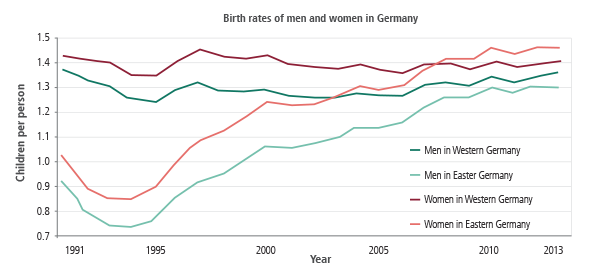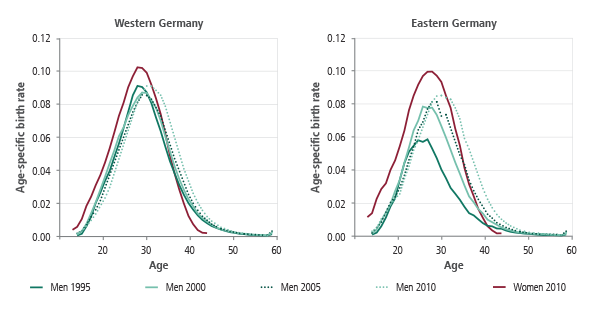July 11, 2017 | News | New Publication
Children born to fathers

A new analysis shows for the first time that the male birth rate in eastern Germany has hit a global record low.
© photocase: altanaka / photocase.com
Research on birth rates mostly focuses on women, while ignoring the role of men in the birth of children. This is largely because of the scarcity of data on male fertility. Two researchers at the Max Planck Institute for Demographic Research in Rostock have used statistical methods to show why the birth rates of men as well as of women should be given more attention.
(The following text is based on the original article Estimating male fertility in eastern and western Germany since 1991: a new lowest low? by MPIDR researchers Christian Dudel and Sebastian Klüsener and has with minor changes also been published in the issue 2/2017 of the demographic quarterly Demografische Forschung Aus Erster Hand.)
Between 1991 and 2003, more than 16 million children were born in Germany. But while we know precisely how many children were born to each woman, we know next to nothing about the birth rates of men. This is because in German birth statistics, data about fathers are included only if the father is married to the mother of the child. Information about fathers of non-marital children was not collected at all until 2000, even though non-marital births make up a large share of all births in eastern Germany in particular. Since 2001, information about the child’s father could be provided on a voluntary basis.
To calculate the birth rates of men as precisely as possible despite these data limitations, Christian Dudel und Sebastian Klüsener of the Max Planck Institute for Demographic Research in Rostock extrapolated the missing data from the information on fathers that was recorded in the statistics, and from the information on mothers. Based on this analysis, the birth rates of men in Germany in the 1991-2013 period have been made available for the first time.
The analysis showed that compared to women, men tend to have fewer children (see Fig. 1), to have their children later in life, and to space the births of their children over a longer age range. The trends in the birth rates of men and women are roughly parallel, as they are estimated based on the same number of births. However, these births are distributed across a greater number of men because men make up a majority of the population, partly as a result of the predominance of men among immigrants to Germany. At the same time, a statistical effect arises: because men are able to have children over a longer age range than women, there are more men of reproductive ages across whom these newborn children can be distributed.

Fig. 1. Because there are more potential fathers than mothers, the birth rate of men is around five to 10 percent lower than the birth rate of women. A previously unknown record low was reached in eastern Germany in the mid-1990s: at that time, the birth rate was 0.74 children per man. FDZ 2016, own calculations.
In 2013, the average birth rate was 1.35 children per man, but 1.42 children per woman. Generally, the birth rates of men are lower than those of women; by around four percent in western Germany and by as much as 10 percent or more in eastern Germany. This large discrepancy in the east arose in part because in the 1990s and the 2000s more women than men emigrated from the east, which led to an increase in the surplus of men in this region. The male birth rate in eastern Germany was particularly low in 1994. The analysis shows for the first time that the birth rate for this group of men was just 0.74 children per man. This rate represents a new worldwide record low, and is even lower than much-discussed record low birth rate of 0.85 children per woman set by eastern German women in 1994.
This finding is of particular importance because this low birth rate suggests that in eastern Germany there will soon be a generation of older men who are especially likely to be childless. Thus, it may be expected that many of these men will be dependent on assistance from the state when they start to require nursing care. While this situation has been less acute since the middle of the 1990s, even today the birth rates of men in eastern Germany are lower than the birth rates of men in western Germany.

Fig. 2: Trend toward delayed fatherhood: the average age of men at the birth of their children has increased markedly since 1995. Source: FDZ 2016, own calculations.
But in both parts of Germany, there is a clear trend toward men having children later in life (see Fig. 2). Between 1995 and 2010, the average age of fathers at childbirth rose 1.4 years in the west, but 2.6 years in the east. However, with an average age of 32.4 at childbirth, men in the east are still around half a year younger than men in the west (33.1) when they have children. Compared to women, men are more likely to have their children over a longer time span, especially at higher ages: whereas six percent of all births are to fathers aged 45 or older, just 0.2 percent of all births are to mothers in this age group.
Co-author of the scientific study: Christian Dudel
More Information